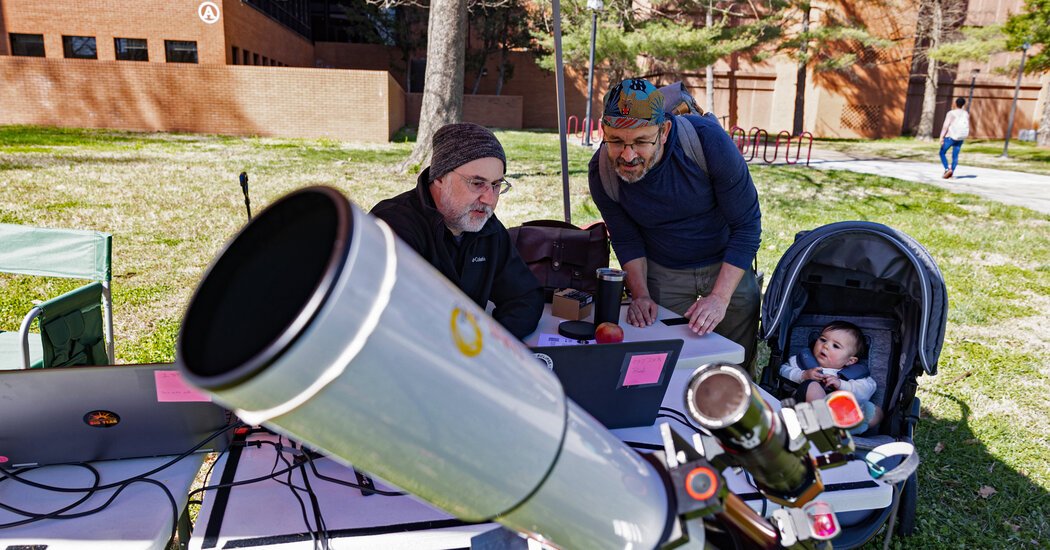It is rare for a total solar eclipse to hit the same place twice — once every 366 years on average. In 2019, this happened in the Pacific Ocean, far west of the coast of Chile. By a stroke of luck, the next one will span a region of about 10,000 square miles that includes parts of southern Illinois, southeastern Missouri and western Kentucky.
People in those areas will encounter April 8’s eclipse about seven years after they were near the middle of the path of the “Great American Eclipse.”
For that total eclipse, which occurred on Aug. 21, 2017, Southern Illinois University sold out its football stadium in the city of Carbondale.
“We had people screaming,” said Bob Baer, the director of the university’s astronomy observation program. “But unlike a football game, you had them all screaming for the same thing.”
The college town, with a population of nearly 22,000, was among the most popular hot spots in the Midwest for the 2017 eclipse. Now, Carbondale and its neighbors are getting ready for another day with no sun. While towns in the area averaged around two and half minutes in the darkness of totality in 2017, this time they will experience about four minutes of totality. Preparation and hype have increased, too.
Mr. Baer first heard that Carbondale, five hours south of Chicago, was in the crossroads of two solar eclipses nearly a decade before the 2017 event. But the significance didn’t click for him until 2014, when an astronomer from the National Solar Observatory reached out.
“Once I understood, I about fell out my chair,” Mr. Baer said, though he struggled to convince anyone else. “When I started talking to people about the eclipse, their eyes would gloss over. I’d lose them in the first 20 seconds.”
That started to change as August 2017 got closer. Carbondale, which planned for that eclipse for three years, welcomed around 14,000 people. Clouds obstructed much of the view that day, but the communal experience struck people nonetheless. Excitement from that event continues to reverberate seven years later.
“The vibe is still pretty electric here,” Mr. Baer said. “A lot of anticipation.”
Not everyone was as prepared as Carbondale was in 2017. Seventy miles away, city officials in Paducah, Ky., were surprised by the number of visitors they got.
“We had no idea what to expect,” said Angela Schade, a downtown development specialist in Paducah’s planning department. She remembers locals renting out their yards to campers in an attempt to make room for everyone coming for the eclipse. Ms. Schade watched the spectacle from the parking lot at work but didn’t fully comprehend what she was experiencing.
This year, Paducah is organizing a street fair where educators will teach people about the science of eclipses. The National Quilt Museum — Paducah’s claim to fame — will host an exhibition featuring the work of Karen Nyberg, a retired NASA astronaut who makes space-themed quilts.
Ms. Schade is also making sure that Paducah’s streetlights don’t automatically switch on when the sun vanishes.
Paducah was not the only town in the crossroads to be overwhelmed in 2017. In Makanda, Ill., a village with a population of fewer than 600, a wave of 12,000 people turned out to see the eclipse.
“We had all hands on deck,” said Debbie Dunn, a festival event coordinator there. The town, which sat smack in the middle of the eclipse path, experienced the longest duration of totality. One artist painted a neon orange line across town — and through his own studio — to mark the centerline of the moon’s shadow.
Makanda will not be the site of longest totality again in April — that will be near Torreón, Mexico. But according to Ms. Dunn, interest in the eclipse seems higher than it was in 2017.
“All our neighboring communities have got all these things planned,” she said, adding that last time Carbondale was the only place in southern Illinois that did anything big.
Events aren’t limited to the day of the eclipse — communities are planning festivities for the weekend before and the evening after totality. Part of this is strategic: Makanda is hosting a dance on the night of April 8, for example, in the hopes of mitigating the kind of post-eclipse traffic jams that paralyzed the town in 2017.
Pat Hunt, who runs Apple Creek Vineyard & Winery with her family in Friedheim, Mo., is organizing a weekend of live music and food.
Ms. Hunt described the experience at her vineyard in 2017 as chaotic, mainly because no one knew how many people would show up. “We just had some nightmares the first time around,” she said. “We weren’t as prepared as we needed to be.”
This time, they are selling tickets to control the arrival of visitors and adding 10 employees to help on eclipse day, many focused on traffic and parking.
College towns seemed to be better prepared in 2017. “We were not caught off guard,” said Bruce Skinner, the chair of the eclipse committee at Southeast Missouri State University in Cape Girardeau. In 2017, the event coincided with the first day of classes, so the university rolled it into the orientation activities.
On April 8, classes will be canceled for a schoolwide block party. Many students will assist NASA-funded research projects.
After that, it won’t be until 2045 that a total solar eclipse comes anywhere near this region lucky enough to see two in seven years.
“For many of the people that are going to see it, it is a once-in-a-lifetime event,” Dr. Skinner said. But for those caught in the crossroads, “it’s going to be a twice-in-a-lifetime thing.”

